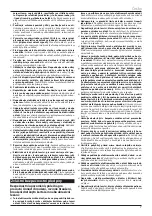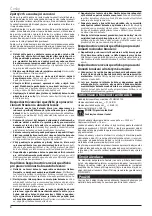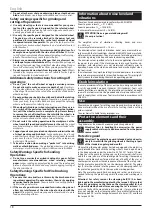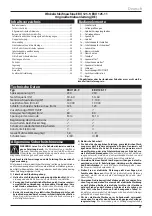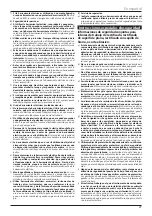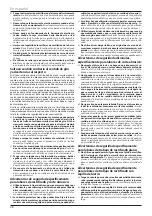
English
18
e)
Do not attach a saw chain woodcarving blade or toothed saw
blade.
Such blades create frequent kickback and loss of control.
Safety warnings specific for grinding and
cutting‑off operations:
a)
Use only wheel types that are recommended for your power
tool and the specific guard designed for the selected wheel.
Wheels for which the power tool was not designed cannot be ade-
quately guarded and are unsafe.
b)
Use only the specific guard designed for the selected wheel.
The guard must be securely attached to the power tool and
positioned for maximum safety, so the least amount of wheel
is exposed towards the operator.
The guard helps to protect the
operator from broken wheel fragments and accidental contact
with the wheel.
c)
Wheels must be used only for recommended applications. For
example: do not grind with the side of cut‑off wheel.
Abrasive
cut-off wheels are intended for peripheral grinding, side forces ap-
plied to these wheels may cause them to shatter.
d)
Always use undamaged wheel flanges that are of correct size
and shape for your selected wheel.
Proper wheel flanges support
the wheel thus reducing the possibility of wheel breakage. Flanges
for cut-off wheels may be different from grinding wheel flanges.
e)
Do not use worn down wheels from larger power tools.
Wheels
intended for larger power tools are not suitable for the higher
speed of a smaller tool and may burst.
Additional safety instructions for cutting‑off
operations:
a)
Do not “jam” the cut‑off wheel or apply excessive pressure.
Do not attempt to make an excessive depth of cut.
Overstress-
ing the wheel increases the loading and susceptibility to twisting
or binding of the wheel in the cut and the possibility of kickback or
wheel breakage.
b)
Do not position your body in line with and behind the rotating
wheel.
When the wheel, at the point of operation, is moving away
from your body, the possible kickback may propel the spinning
wheel and the power tool directly at you.
c)
When wheel is binding or when interrupting a cut for any rea‑
son, switch off the power tool and hold the power tool motion‑
less until the wheel comes to a complete stop. Never attempt
to remove the cut‑off wheel from the cut while the wheel is in
motion otherwise kick‑back may occur.
Investigate and take cor-
rective action to eliminate the cause of wheel binding.
d)
Do not restart the cutting operation in the workpiece. Let the
wheel reach full speed and carefully reenter the cut.
The wheel
may bind, walk up or kickback if the power tool is restarted in the
workpiece.
e)
Support panels or any oversized workpiece to minimise the risk
of wheel pinching and kick‑back.
Large workpieces tend to sag
under their own weight. Supports must be placed under the work-
piece near the line of cut and near the edge of the workpiece on
both sides of the wheel.
f)
Take extra caution when making a “pocket cut” into existing
walls or other blind areas.
The protruding wheel may cut gas or
water pipes, electrical wiring or objects that can cause kickback.
Safety Warnings Specific for Sanding
Operations:
a)
Do not use excessively oversized sanding disc paper. Follow
manufacturers recommendations when selecting sanding
paper.
Larger sanding paper extending beyond the sanding pad
presents a laceration hazard and may cause snagging, tearing of
the disc or kickback.
Safety Warnings Specific for Wire Brushing
Operations:
a)
Be aware that wire bristles are thrown by the brush even dur‑
ing ordinary operation. Do not overstress the wires by applying
excessive load to the brush.
The wire bristles can easily penetrate
light clothing and/or skin.
b)
If the use of a guard is recommended for wire brushing, do not
allow any interference of the wire wheel or brush with the
guard.
Wire wheel or brush may expand in diameter due to work
load and centrifugal forces.
Information about noise level and
vibrations
The values have been measured in conformity with EN 60745.
Acoustic pressure level L
pA
= 91.2 dB (A).
Acoustic power level L
wA
= 102 dB (A).
In accuracy of measurements K = 2 dB (A).
ATTENTION! Noise is generated during work!
Use ear protection!
The weighted value of vibrations affecting hands and arms
a
h
= 20.25 m.s
-2
.
In accuracy of measurements K = 1.5 m.s
-2
.
The emission values specified (vibration, noise) were measured in ac-
cordance with the test conditions stipulated in EN 60745 and are intend-
ed for machine comparisons. They are also used for making preliminary
estimates regarding vibration and noise loads during operation.
The emission values specified refer to the main applications for which
the power tool is used. If the electric power tool is used for other ap-
plications, with other tools or is not maintained sufficiently prior to
operation, however, the vibration and noise load may be higher when
the tool is used.
Take into account any machine idling times and downtimes to estimate
these values more accurately for a specified time period. This may signif-
icantly reduce the load during the machine operating period.
Double insulation
To ensure maximum safety of the user, our tools are designed and built
to satisfy applicable European standards (EN standards). Tools with
double insulation are marked by the international symbol of a double
square. These tools must not be grounded and a two-wire cable is suffi-
cient to supply them with power. Tools are shielded in accordance with
EN 55014.
Use
The machine is designed for splitting, roughing and brushing metal and
stone materials without the use of water. For cutting stone, a cutting
guide is required.
The user himself is liable for any improper use.
Protective elements and their
assembly
The grinder may be used with mounted protective guard only!
Attention! Prior to handling the accessories, the power
supply cable has always to be disconnected from the power
source socket!
Protective guard
Attention! The protective guard intended only and exclu‑
sively for work with the grinding wheels is the integral part
of the standard angular grinder outfit.
When cutting, the angular grinder has to be equipped by the protective
guard intended for work with the cutting wheels; it can be purchased
in the trade network under the order No. 00 763 301 for dia. 125 mm.
Failing to use the guard for cutting, you run the increased risk of injury
and in this case (non-use of the special guard for cutting) the company
Narex is not liable anyhow for possible harm of health of the user or
another person injured as the consequence of breach of the safety rules.
Put the protective guard (8a; 8b) on the clamping collet (6). The guide
lugs (9) must be inserted into the grooves on the clamping collet. Set
the protective guard (8a; 8b) to the requested working position.
Note: The protective guard has been designed so that no tool may be
needed for fixing the protective guard in the requested working posi-
tion.
Attention! For safety reasons the clamping bolt (10) has been
tightened in the manufacturing plant by the torque 3.5 Nm so that
the safety guard may not be loose on the clamping collet (6), but
may be swiveled by hand after overcoming the set resistance.
It is
necessary to check the mounted protective guard - it may not be loose
(may not wobble) on the clamping collet. For possible tightening the
clamping bolt (10) use the hexagonal wrench dia. 4 mm (18) and check
the torque 3.5 Nm.
Содержание EBU 125-11
Страница 3: ...3...
Страница 4: ...4 1 2 2 3 4 5 6 7a 7b 8 8 9 9 10 11 12 13 14 15 16 16 17 19...
Страница 5: ...5 7a 7b 8 5 9...
Страница 32: ...o 32 RCD RCD 3 a 4 a 5 a a...
Страница 33: ...o 33 a...
Страница 46: ...46...
Страница 47: ...47...




